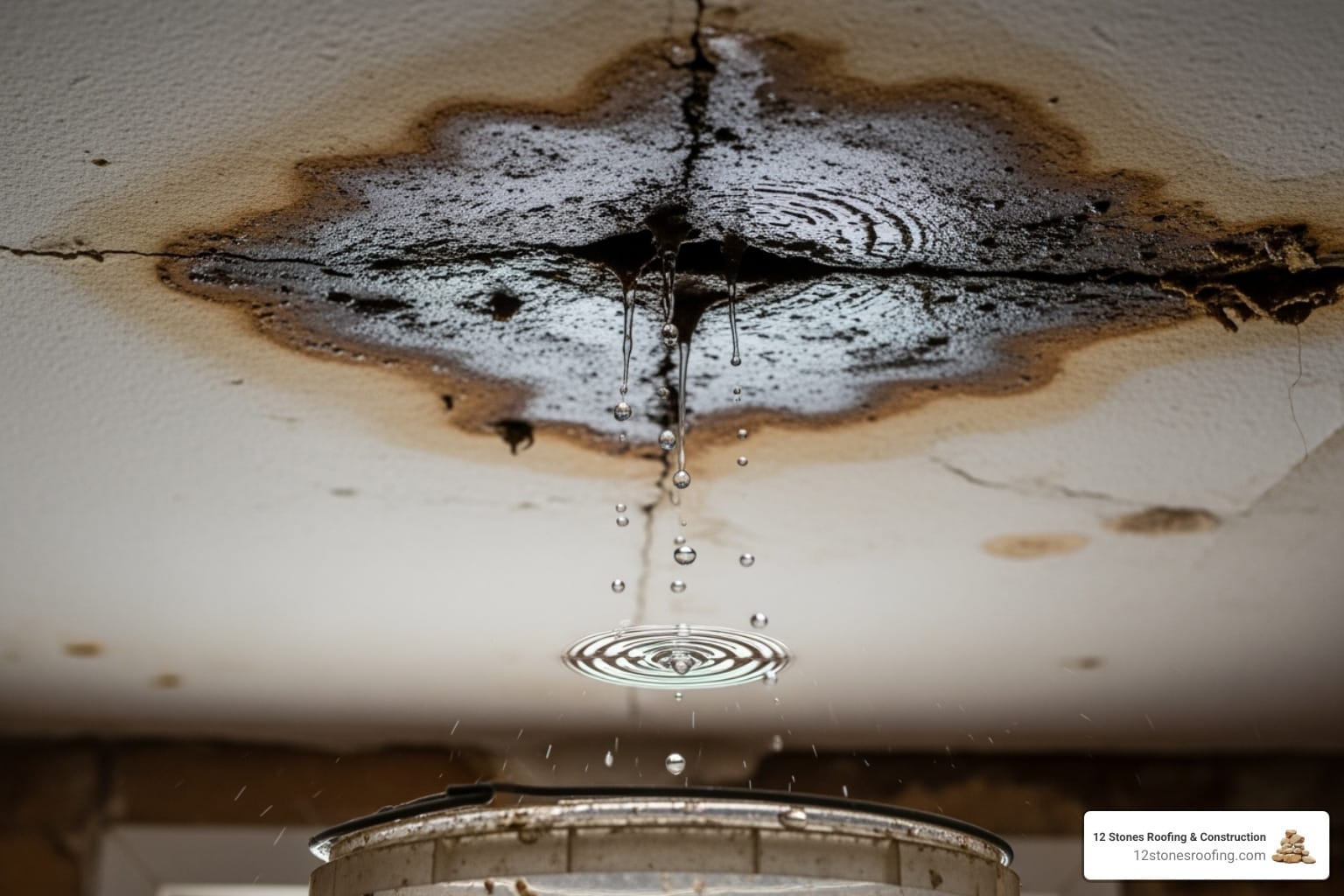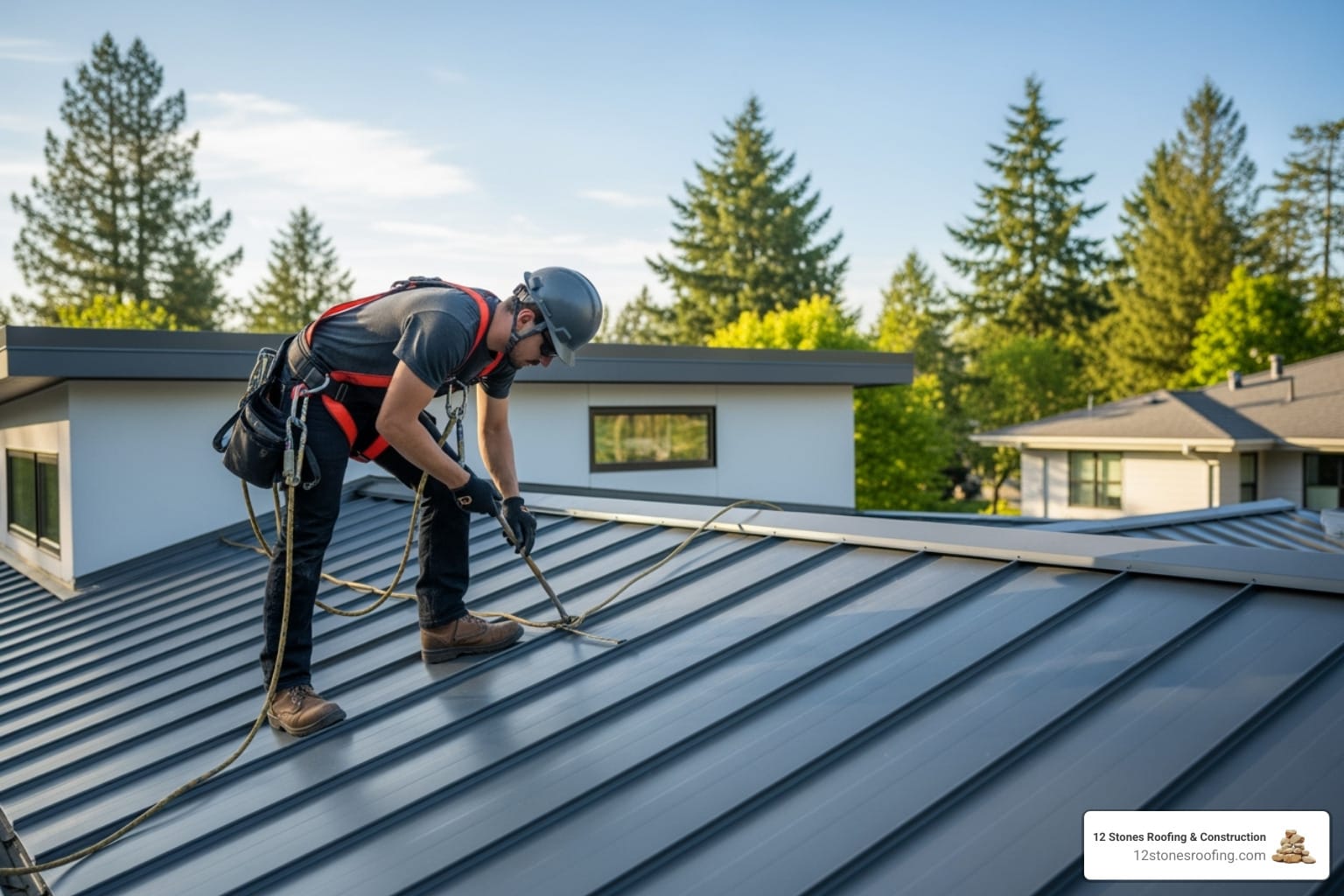Why Hail Damage Demands Immediate Action
Hail damage roof repair is an urgent issue for Texas homeowners. In 2022 alone, over 4,400 severe hail reports led to billions in property damage. Knowing how to respond can save you thousands and protect your home’s structural integrity.
Quick Answer for Hail Damage Roof Repair:
- Immediate Steps: Inspect from ground level, document all damage with photos/videos, contact insurance within your policy’s deadline.
- Average Costs: $940 for repairs, $9,100 for full replacement (often covered by insurance).
- Professional Help: Required for safety, hidden damage detection, and maximizing insurance claims.
- Timeline: Act fast – insurance claims must be filed within your policy’s deadline (typically 6 months to 2 years).
Texas hailstorms appear without warning, leaving devastating damage. State Farm reported a $1 billion increase in hail claim costs in 2022 due to more frequent storms. Even half-inch hail can damage asphalt shingles, while one-inch hail can bruise underlayment and cause significant exterior damage.
After a major storm, ensuring your home is secure with a trusted local roofing expert is the first step toward peace of mind. Many homeowners make the costly mistake of ignoring what appears to be minor damage, only to find extensive water infiltration and structural issues months later.
As Jason Roberts, Owner of 12 Stones Roofing & Construction, I’ve seen how a proper hail damage roof repair assessment and prompt action prevent catastrophic renovations. This guide will walk you through every step, from initial assessment to final repairs.
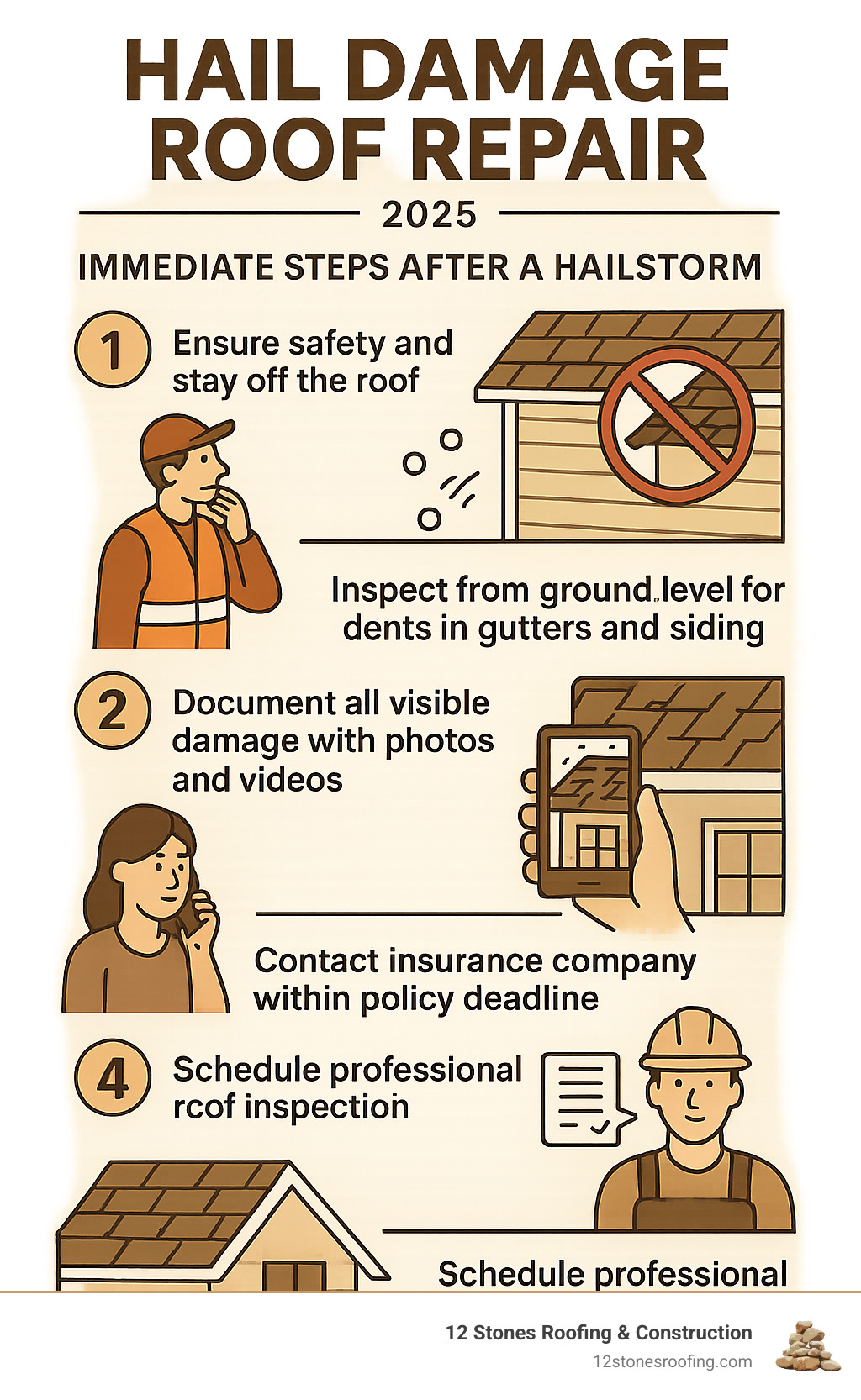
First Steps After a Hailstorm: Assessing the Damage
![IMAGE of a homeowner inspecting dented gutters and downspouts from the ground]
After a hailstorm, resist the urge to immediately climb a ladder to your roof. Safety is paramount, and a potentially damaged, wet, or slippery roof is dangerous.
Instead, start with a ground-level inspection. You can find many clues about hail damage without ever leaving solid ground.
What should you be hunting for? Walk around your home and look for dented gutters and downspouts. These metal surfaces show impact damage clearly, and if your gutters are dented, your roof likely took some hits too.
Examine your damaged siding for cracks, chips, or dings, and check window screens for tears. A useful trick is to look for spatter marks on your driveway. When hail hits concrete, it can knock away dust, leaving cleaner spots that show where stones landed.
One of the most telling signs is granule buildup in your downspouts. These granules protect asphalt shingles from UV rays. When hail knocks them loose, they wash into your gutters. A collection of what looks like coarse sand at the bottom of your downspouts is a red flag.
Documenting everything is crucial for your insurance claim. Use your phone to take photos and videos from multiple angles, getting both close-ups and wider shots.
For those curious about the science behind these destructive ice balls, the National Severe Storms Laboratory has great information about hail formation and why Texas sees so much of it.
After your ground-level inspection and documentation, call a professional. A trained eye can spot subtle hail damage roof repair issues that cause future problems. A professional inspection reveals hidden damage that might not appear for months.
What Are the Signs of Hail Damage on a Roof?
Knowing what to look for can help you understand whether you need hail damage roof repair services. Here are the key indicators:
- Dents on gutters, downspouts, and roof vents are your most obvious clues. Hail leaves its mark on soft metal surfaces.
- Cracks or chips in siding tell their own story. Vinyl siding might crack, while painted surfaces often show chips where hail struck.
- Granules collecting at the bottom of downspouts signal that your shingles took a beating, leaving them vulnerable to UV damage.
- Damaged window screens or frames are easy to spot and often indicate that your roof absorbed similar impacts.
Trickier signs require a professional. Bruising on shingles creates weak spots that can crack and leak. An exposed fiberglass mat indicates compromised protective layers, and weakened self-seal strips increase vulnerability to wind damage. These subtle signs are why professional assessment is so important for hail damage roof repair.
Understanding the Severity: How Different Roofs Handle Hail
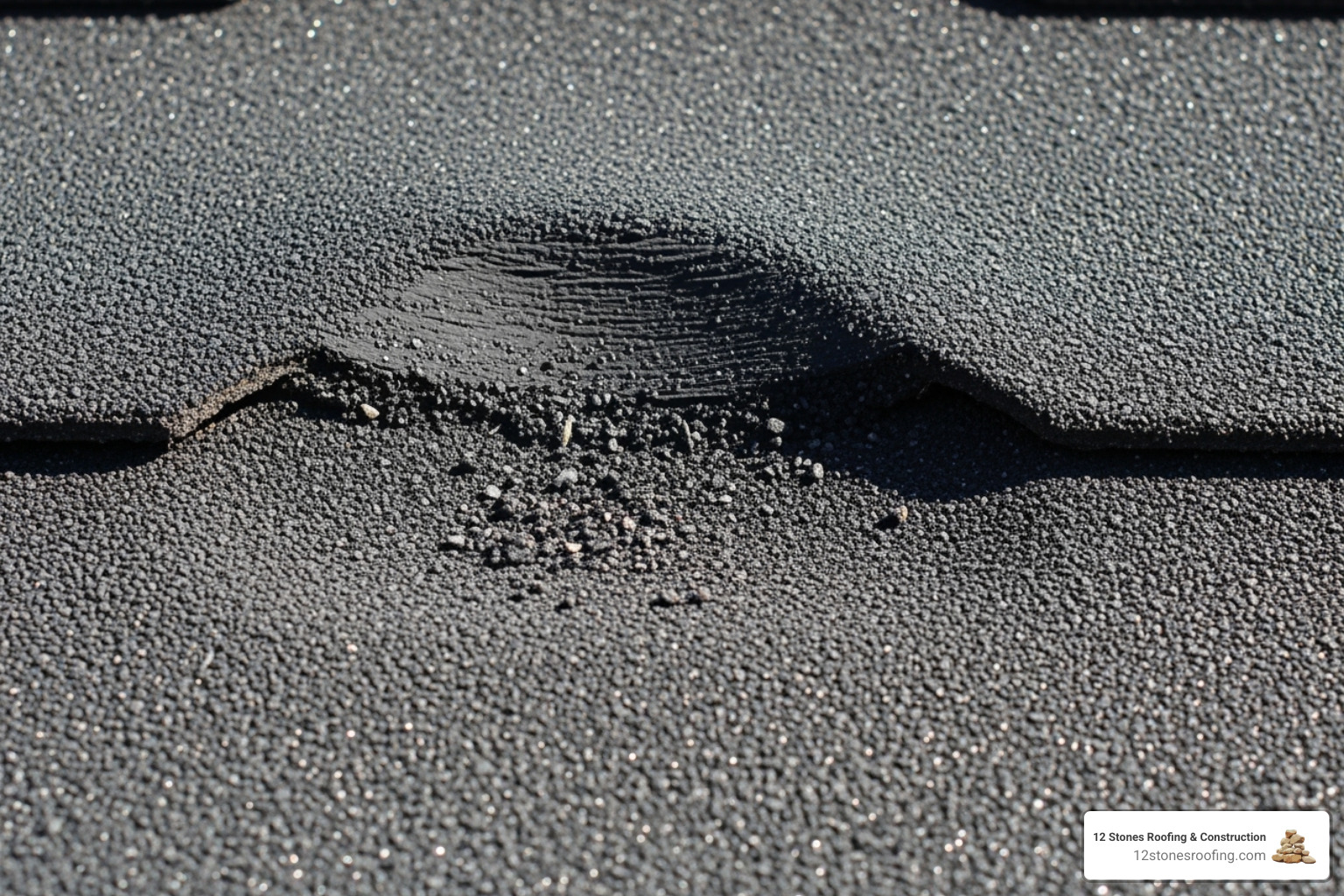
Not all roofs respond to hail the same way. The necessary hail damage roof repair depends on your roofing material, its age, and the storm’s severity.
It’s important to understand the difference between functional and cosmetic damage. Cosmetic damage, like minor dents or slight granule loss, affects curb appeal but doesn’t immediately threaten your home. Functional damage is the real problem, as it compromises your roof’s ability to protect your home from the elements.
Ignoring even minor damage gets expensive quickly. Water infiltration leads to structural weakness from rotting wood, mold and mildew growth that poses health risks, and interior damage to ceilings, walls, and insulation.
The size of hailstones makes a huge difference. According to research from the National Association of Certified Home Inspectors, hail just one inch in diameter can damage three-tab asphalt shingles. Architectural shingles may hold up until hail reaches 1.25 inches, while concrete tiles typically need two-inch hailstones to cause significant damage.
Many homeowners don’t realize that even small hail causes problems over time. Combined with high winds or a long storm, the cumulative effect shortens your roof’s lifespan, even without obvious initial damage.
Different roofing materials handle hail differently. Asphalt shingles are prone to granule loss and bruising. Metal roofing resists functional damage but can dent. Clay and concrete tiles are tough but can crack from large hailstones. Wood shakes are vulnerable to splits and punctures.
Does Hail Damage Always Require a Full Roof Replacement?
No, not always. Many homeowners worry that any hail damage means a complete roof replacement, but that’s often not the case.
Minor damage can often be handled with spot repairs. Individual shingle replacement is cost-effective when your roof is relatively new and the damage is isolated.
However, full replacement becomes necessary when damage is widespread. Extensive granule loss, bruising, or cracking across multiple sections makes piecemeal repairs impractical. Roof age is also a crucial factor; older roofs are more vulnerable and may not respond well to partial repairs.
A thorough professional assessment is key to making the right decision. Our team spots hidden damage and provides an honest evaluation of whether you need targeted fixes or a complete roof repair or replacement. While the average replacement costs around $9,100, it’s a crucial investment in your home’s long-term safety and value.
The Financial Side: Costs and Insurance for Hail Damage
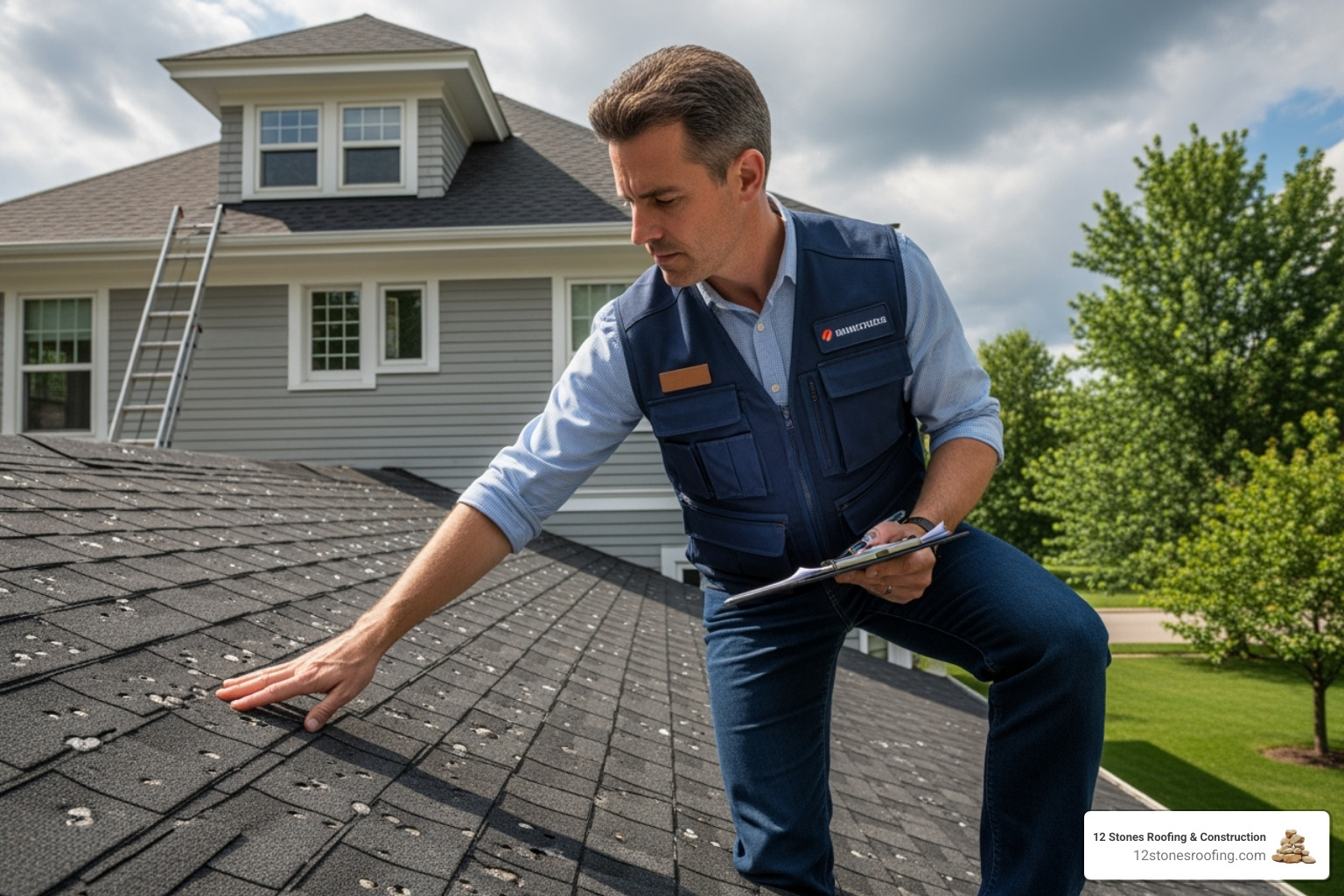
Understanding the financial side of hail damage roof repair is crucial for making smart decisions and avoiding surprises. The good news is that most repairs are more affordable than homeowners expect.
The average repair cost is around $940, with minor fixes starting as low as $20. However, a full roof replacement averages about $9,100 and can climb to $25,000 or more in cases of severe interior damage.
Several factors determine your final cost. Material type is a major driver—asphalt shingle repairs cost less than premium materials like slate. Labor rates, roof size and slope, and the extent of damage also play significant roles. Hail often damages gutters, siding, and windows, adding to the total bill.
Insurance is your best friend in this situation. Most homeowners policies cover hail damage, but timing is critical. You typically have 6 to 24 months to file a claim, depending on your policy. Missing this deadline can mean paying thousands out of pocket for what should have been a covered repair.
Understanding your homeowners insurance policy before a storm saves headaches. Our team at 12 Stones Roofing has extensive experience with the insurance claims process and can help ensure you get the compensation you deserve.
What is the Difference Between ACV and RCV Policies?
This is a critical insurance lesson. Your policy type—ACV or RCV—massively impacts your out-of-pocket costs for hail damage roof repair.
Actual Cash Value (ACV) policies pay what your roof is worth today, including depreciation. If a replacement costs $15,000 but your depreciated roof is valued at only $8,000, you’re responsible for the $7,000 difference.
Replacement Cost Value (RCV) policies are usually better for homeowners. They pay to replace your damaged roof with new, similar-quality materials, regardless of age. You typically get an initial ACV payment, followed by a second “recoverable depreciation” payment after repairs are complete.
The difference between ACV and RCV can mean thousands of dollars. We always recommend reviewing your policy with your agent, especially in hail-prone areas like Texas. Your deductible, typically 1% to 5% of your dwelling coverage, also affects your final cost.
The Hail Damage Roof Repair Process: Hiring a Pro vs. DIY
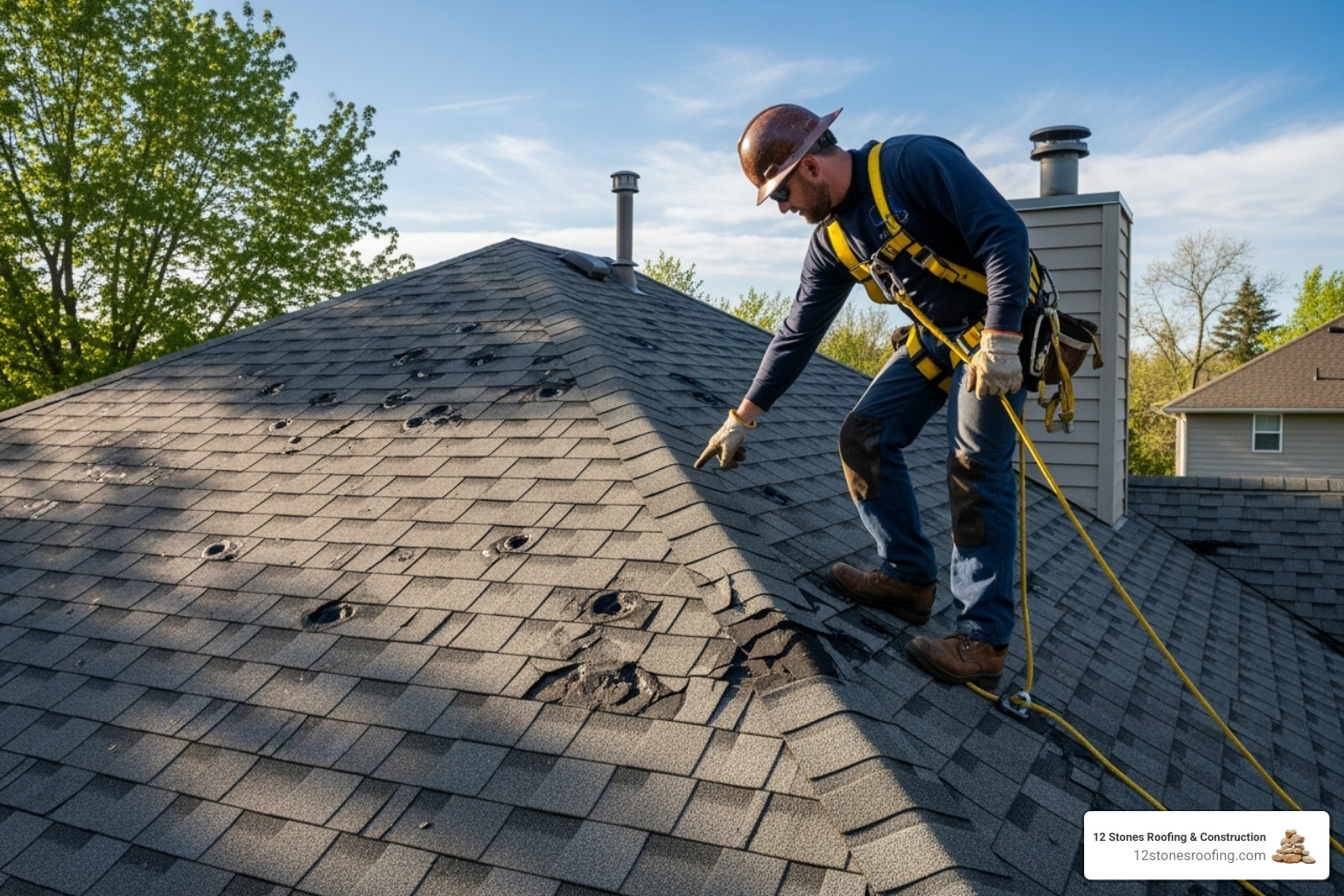
After a hailstorm, you might be tempted by a DIY fix. While the DIY spirit is strong in Texas, for hail damage roof repair, it’s dangerous.
Let’s talk about the real risks of DIY roof repair. Safety hazards are the primary concern; falls from roofs cause thousands of serious injuries annually. Without proper safety equipment, you’re at risk.
Inexperience is another major problem. Hail damage is often hidden. What looks like minor granule loss might be a bruised shingle mat that will fail in six months, leading to leaks and mold.
Attempting DIY repairs could also void your existing warranty, as many manufacturers require professional installation to maintain coverage.
Professional roofers bring best expertise from inspecting thousands of hail-damaged roofs. Our teams work efficiently and safely with proper equipment, minimizing disruption. Reputable companies also offer a warranty on their workmanship, giving you confidence the job is done right.
Why Professional Hail Damage Roof Repair is Crucial
Professional hail damage roof repair is about more than just new shingles. Our trained eyes perform hidden damage detection, catching issues like fractured fiberglass mats and weakened self-seal strips that homeowners miss.
Preventing future leaks is where professional expertise shines. A proper repair restores your roof’s protective barrier, preventing water infiltration that causes interior damage, mold, and structural problems.
Ensuring code compliance is another key benefit. Professionals stay current on local building codes, protecting your safety and preventing issues when you sell your home.
A key benefit is maximizing insurance claims. Experienced roofers properly document damage and communicate effectively with adjusters, often securing a better settlement for you.
The long-term peace of mind from a professional repair is invaluable. You can rest easy knowing your home is protected for years to come. The dangers of ignoring damage are severe; a small issue today can become a costly nightmare if left untreated.
Choosing a Contractor for Your Hail Damage Roof Repair
Finding the right contractor for hail damage roof repair isn’t overwhelming. Start by checking for license and insurance. Verify they carry liability and workers’ compensation to protect you from accidents on your property.
Reading online reviews on Google, Yelp, and the BBB reveals a contractor’s reputation. Getting multiple written estimates helps you compare options fairly. Be wary of estimates that seem too good to be true.
Experience with hail damage is critical. Ask about their track record with storm damage and insurance claims. Understanding the contract and payment terms protects you from surprises. Never work with a contractor who demands full payment upfront.
Local expertise is a major advantage. Local contractors understand Texas weather, building codes, and have established relationships with suppliers.
For over 15 years, 12 Stones Roofing & Construction has served Pasadena and nearby communities. As CertainTeed Master Shingle Applicators and ShingleMasters, we meet the highest standards for workmanship and customer service.
12 Stones Roofing & Construction
Address: 6933 Olson Ln, Pasadena, TX 77505
Phone: (832) 815-9463
We understand the unique challenges Texas storms present. Our local knowledge and commitment to transparent, reliable service mean you can trust us to protect your home.
Frequently Asked Questions about Roof Hail Damage
After helping thousands of Texas homeowners with hail damage roof repair, we’ve noticed the same questions come up repeatedly. Let’s tackle the most common ones.
How long do you have to file an insurance claim for hail damage?
Many homeowners are surprised to learn there’s a deadline to file an insurance claim. Most policies allow six months to two years from the storm date, but this varies significantly. In Texas, a one-year deadline is common.
Too many homeowners miss this window, thinking minor damage isn’t a concern, only to find extensive problems when it’s too late to file. The clock starts ticking from the storm date, not when you find the damage. That’s why we always say: don’t wait. Contact your insurance company even if you’re unsure about the damage.
Will my insurance policy cover hail damage to my roof?
In most cases, yes. Hail damage is typically a “covered peril” in standard homeowners insurance policies. However, the details matter. Some policies have a Cosmetic Damage Exclusion, meaning if hail only caused cosmetic damage without affecting function, your insurer might not pay. This is increasingly common in hail-prone areas.
Your deductible is another key factor. You must pay this amount before coverage begins. In Texas, many policies have percentage-based deductibles for hail, sometimes 1% to 5% of your dwelling coverage, which can be a substantial amount.
We recommend reviewing your specific coverage with your insurance agent to understand any exclusions or limitations that affect your hail damage roof repair coverage.
What are the risks of ignoring hail damage to a roof?
Ignoring hail damage is a serious mistake. The problem won’t go away and will likely worsen.
Water infiltration is the biggest threat. Minor bruises on shingles create weak spots where water can penetrate, soaking insulation and attacking your home’s structure.
We’ve seen attics with severe mold growth because homeowners waited too long. Mold creates a health hazard, especially for those with respiratory issues. It’s not just unsightly; it’s dangerous.
The financial impact can escalate quickly. An average repair can balloon into tens of thousands when water damage spreads to your interior. We’ve seen homeowners face over $50,000 in costs because they ignored initial damage.
Worse, insurance companies can deny claims due to homeowner neglect. If you wait to address obvious hail damage and it worsens, your insurer may argue the additional damage was preventable, leaving you to pay for repairs that should have been covered.
The bottom line is that small problems don’t stay small. Early action is essential to protect your home and your finances.
Conclusion
Navigating hail damage roof repair doesn’t have to be overwhelming. We’ve covered the essentials: safe ground-level assessment, thorough documentation, understanding how different roofs handle hail, and making sense of insurance.
The bottom line? Time is your friend when you act quickly, but your enemy when you don’t. Damage that looks minor today can snowball into a major headache. That small bruise on a shingle might seem insignificant, but Texas weather can turn small problems into big ones fast.
Functional damage—anything compromising your roof’s protective ability—needs immediate professional attention. Even with cosmetic damage, a professional check is wise to ensure no hidden issues exist.
At 12 Stones Roofing & Construction, we’ve seen how proper hail damage roof repair assessment and prompt action can save homeowners thousands. We’re not just here to fix your roof; we’re here to guide you through the entire process, from the first call to the final cleanup.
Our team understands the challenges Texas storms bring. We know how to work with insurance companies, spot hidden damage, and restore your peace of mind along with your roof’s integrity.
Don’t let a small leak turn into a major renovation. Your home is your biggest investment, and it deserves protection from professionals who get the job done right. Contact our team of experts in Pasadena for a free, no-obligation inspection and let us help you weather whatever storms come your way.



